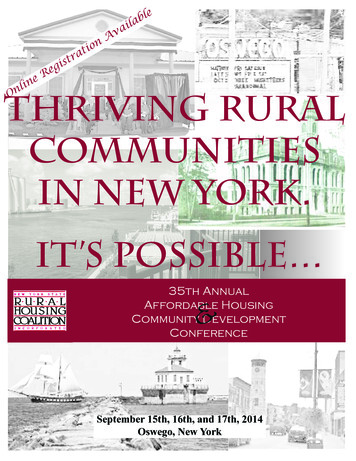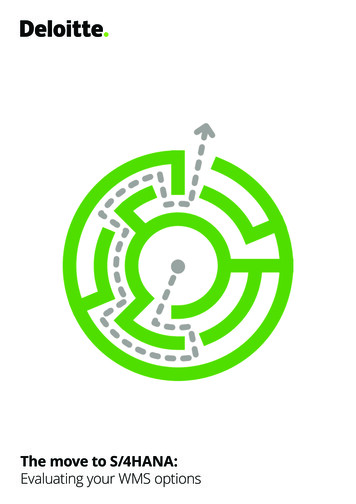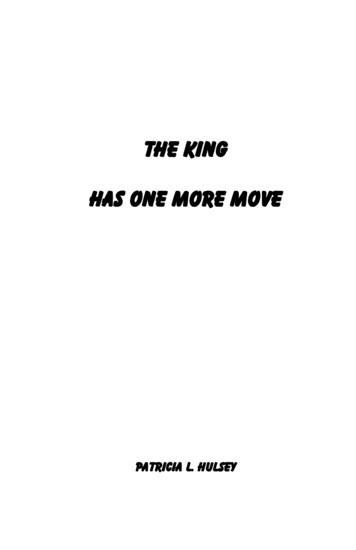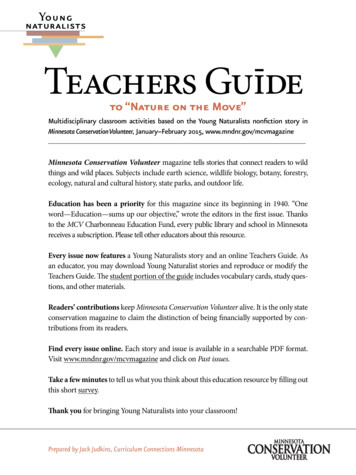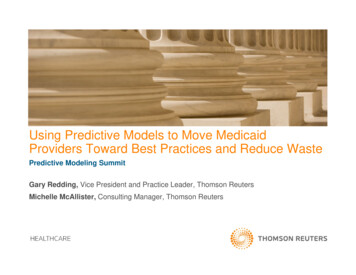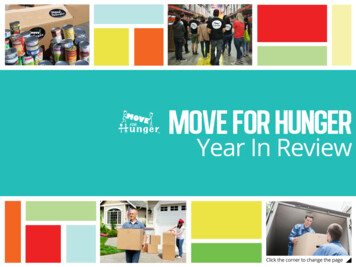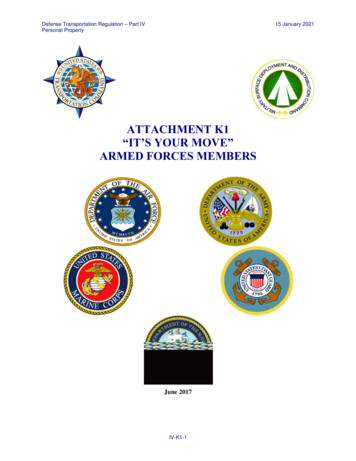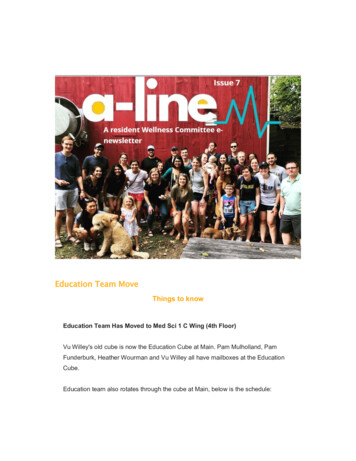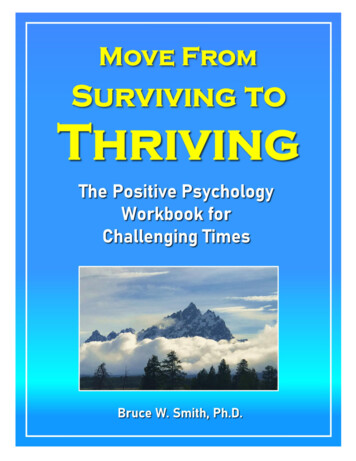
Transcription
2Move FromSurviving toThriving:The Positive PsychologyWorkbook forChallenging TimesFirst EditionBruce W. Smith, Ph.D.
3Dear Reader,This workbook is freely offered to anyone who wants touse it to create a life of greater joy, happiness, meaning,and fulfillment in spite of the challenges we often face.You have my permission to use anything in thisworkbook as long as you use it for increasing humanhappiness and well-being and make it as freely available asyou can.If you would like a printed copy of this workbook, it isavailable at minimal not for profit cost of approximately 6.00, go to:Bruce W. Smith on 7V58?ref dbs a def rwt bibl vu00 i0Please feel free to email us at cappnmusa@gmail.com ifyou have any questions or if the above link is not working.Warmly,Bruce W. Smith
4Kindle Direct PublishingSeattle, WA, USAISBN: 9798571856447Copyright 2020Bruce W. Smith
5Table of ContentsPreface. 7Acknowledgements . 9How to Use this Workbook . 11Part 1 - Basic Training for Your Best Life . 13Chapter 1: A Call to Adventure . 15Chapter 2: What Do You Want Most?. 23Chapter 3:How Can You Make It Happen? . 31Chapter 4:Mindfulness and Acceptance . 37Chapter 5: Resilience and Stress-Related Growth. 43Chapter 6: Wisdom and Creativity. 50Part 2 – Bringing Out Your Best. 57Chapter 7: Discovering Your Best . 59Chapter 8: Authenticity . 67Chapter 9: Perseverance . 75Chapter 10: Courage. 83Chapter 11: Self-Efficacy . 89Chapter 12: Self-Control. 96Part 3 – Bringing Out the Best Around You .103Chapter 13: Social Intelligence. 105Chapter 14: Love. 113Chapter 15: Kindness . 121
6Chapter 16: Community Positive Psychology . 127Chapter 17: Fairness and Justice . 133Chapter 18: Forgiveness . 140Part 4 – Creating the Best Possible Future .147Chapter 19: Creating a Better Future . 149Chapter 20: Optimism and Hope . 157Chapter 21:Humor . 165Chapter 22: Appreciation and Gratitude . 173Chapter 23: Meaning and Purpose . 180Chapter 24: Review and Celebration . 187Appendix A: Additional Readings .195Appendix B: Positive Psychology Activities .197Appendix C: Links to Author Videos .199Appendix D: Links to Special Videos . 200Appendix E: Well-Being Survey . 202Appendix F: Pleasant Activities List. 204Appendix G: Strength Spotting Tool .210Appendix H: Relationship Appreciative Inquiry . 211Appendix I: Acts of Kindness Planner .213Appendix J: Community Cause Inventory .213Appendix K: Guidelines for the PATH Process . 224
7PrefaceThis workbook is a labor of love and free offering to all who might benefit from it. It isbased on my gratitude for years of being able to teach positive psychology and especially tothe students and teaching assistants who have taught me so much. It is my attempt with thehelp of the Center for Applied Positive Psychology in Albuquerque, New Mexico to offer asmany people as possible the best of what positive psychology, and broader psychology andscience, have to offer each one of us. Positive psychology is the science of happiness andwhat makes life worth living and it is bringing the power of modern science to enable all ofus make the most of our lives and live them to the fullest.I first taught positive psychology at the University of New Mexico in 2005 and it quicklybecame my favorite part of everything I do! Since that first class of 30 students, the classhas continued to grow to include two face-to-face classes of 400 students every year andanother 100-200 students in an online course developed in 2018. The course has been votedthe best class at our university more than once and, most important, I have seen how muchof a difference it can make in the lives of students and in my own life. Since 2016, we havecollected data on how students do during the class and have consistently found thatstudents have significant increases in happiness, well-being, and resilience and decreases inanxiety, depression, and stress.In the past few years, several community leaders and I joined together to form theCenter for Applied Positive Psychology (CAPP) whose mission it is to share the benefits ofpositive psychology to as many people in as many communities as possible. This pastsummer, in response to the uncertainty and stress caused by the COVID-19 pandemic andthe related social, economic, and mental health problems so many were experiencing, thepeople at CAPP and I decided to create a four week “positive psychology challenge” thattook the best of what we know about positive psychology to make it available to others.This challenge, as captured in this workbook, includes what I and other in CAPP havefound to be most beneficial in our teaching, research, and personal experience.Because the initial response to our pilot online challenge was so positive, we decided tomake its benefits as broadly available as possible by creating a workbook to enable anyoneto do it whenever they wanted at their own pace. The positive psychology challenge in thisworkbook contains 24 chapters with lessons that represent the best of positive psychology,the videos that we created to help communicate the lessons, other videos that have beenhighly rated by hundreds of students, questions to help you reflect, learn, and grow, andmost important, the activities and exercises that more than anything will enable you to bringpositive psychology to life. Positive psychology is not a spectator sport, but a participatorysport that we can all take part in and it’s only when we do that we see what it has to offer.
8Now here comes the best news of all. Positive psychology is not just about surviving, it isabout thriving even during the most challenging and stressful times of our lives. Rather thanavoiding or denying the bad things that come our way, positive psychology can enable us toface them, prevail, and use them as opportunities for learning and growth. It is for each andevery day of our life – even when we are under stress, going through a hard time, or tryingto deal with loss, failure, or rejection. In fact, you might even say that positive psychology isespecially for these times because it enables us to be at our best in all circumstances andmake the most of our lives whatever we are going through. More than anything else, thepositive psychology that you can come to experience in this workbook will enable you tobring out the best in yourself so that you can live your life to the fullest.So welcome aboard! You are on a wonderful journey and what has to be one of life’sgreatest adventures. All we ask is that you be open to what you can learn and, mostimportant, try it out for yourself and see what happens!Bruce W. SmithDecember 7, 2020
9AcknowledgementsI began the Preface by staying how grateful I was for the years of being able to teachpositive psychology and all of the students and teaching assistants who have taught me somuch. Now is the time to acknowledge my gratitude for those who have contributed andhelped most with the development of this workbook.First, I am grateful to John Freisinger who took the initiative last summer to invite me towork with him and our group to develop a positive psychology challenge. Despite the factthat we were meeting on Zoom in the throes of a global pandemic, his entrepreneurial spiritwas a catalyst that got us going. Soon after, I started writing lessons and creating videos andJohn first put it all together on an online platform called Vimify that enabled us to pilot thechallenge together.Second, I am grateful to Tanya Kallan, who I have had the great fortune of having asboth a student and later as a teaching assistant for positive psychology classes. Tanya lovedthe idea of putting our initial challenge into a workbook and volunteered to do what hasbeen the great majority of the work in formatting and putting it together. Moreover, she hasdone this during a global pandemic and her first semester of graduate school! As anyonewho meets her can readily see, she is a shining light who naturally embodies the best ofpositive psychology. She is contagious with hope, humor, and good cheer and without herthis workbook would not have been possible!Third, John, Tanya, and I are grateful to the Center for Applied Positive Psychology(CAPP), whose mission it is to share the wealth of positive psychology as broadly aspossible to both individuals and communities. CAPP consists of a rich and diverse group ofcommunity leaders in positive psychology including Paul Smith, a co-founder and leader ofCAPP, who taught positive psychology to hundreds of employees at Sandia NationalLaboratories for many years. In addition, Drs. Steve Poland, Swasti Vohra, and Clara Farahare psychologists who have taught and/or are teaching positive psychology in various formsand settings. We are also grateful to Kelly Ward and Joe Dennis who have years of richexperience bringing the benefits of positive psychology approaches to organizational andwork settings that have affected countless employees and their friends and families. Finally,there are many others in CAPP who have provided support, feedback, and encouragementincluding Alvin Phan, Matthew Higgins, Mary Lemmond, Nancy Fitzgerald, and MarciaMikulak.Fourth, we are all grateful for our students and those we have been able to get to knowand work with for giving us the opportunity to learn together about what can really make ushappy and our lives worth living. There is no better way to learn positive psychology thanseeing it in the lives of other people and there is probably nothing that does more to inspireand bring us hope. We have seen first generation college students who against all oddsgraduated from college and went on to become doctors, lawyers, teachers, and counselors.
10We have seen people confronted by stress, illness, and trauma who have been able to learn,grow, and benefit from the stress they experienced and give something back to the world.We have seen how people of all ages, occupations, countries, and cultures can benefit fromwhat they learn and use it to move their lives to a new and unexpected higher level of joyand happiness. We are grateful to all of these for what they have taught and shown to usand for how it will enable this workbook to come to life for you.Finally, we are most grateful to you for taking the time to read this and make thischallenge a part of your life. We hope that you will come to experience the joy and gratitudethat we have in learning about and sharing the wealth of the growing discoveries in positivepsychology. We wish you all the best in making the most of your lives and living them tothe fullest. Thanks for joining us on the journey!
11How to Use this WorkbookWe are so happy you are taking the opportunity to utilize this workbook to help youovercome obstacles and achieve your best life! As you work through the chapters, you willdevelop a set of tools which use the science and power of positive psychology to youradvantage to empower you to thrive – even when in the midst of life’s challenges.Before you get started, we wanted to give you some suggestions about how to usethis workbook to best fit with your life and schedule.As Bruce Smith noted in the Preface, this workbook grew out of the positive psychologychallenge that he developed with the help of John Freisinger and the Center for AppliedPositive Psychology (CAPP) in Albuquerque, New Mexico. This workbook is somethingthat you can use for yourself, use as part of a group, or lead others in using. The lessons arepresented in an order in which they build upon each other. The sections are: Basic Trainingfor Your Best Life (Part 1), Bringing Out Your Best (Part 2), Bringing Out the Best AroundYou (Part 3), and Creating the Best Possible Future (Part 4).Since you can move through the topics at whatever pace works best for you andyour schedule, you have several options in completing this workbook. You maydecide to do the whole workbook in four weeks as a jump start for a new year (or anytimeyou want to quickly dive in or do a refresher). Or you may want to take it more slowly andcomplete one, two, or three chapters each week. A slower pace could be a great way to fullysavor each topic and dive deeper into each concept. Doing two chapters each week wouldtake three months to complete the workbook. You might find this to be a great way to buildnew habits. Another idea would be to establish a weekly Cultivating My Best Life Day, forexample on a Saturday or Sunday, where you can savor a new chapter for each of twentyfour weeks. This would allow you to try out your skills throughout the week before movingon to the next topic. However you choose to move through the workbook, make sureto try something today, as a gift to yourself!Although the parts and chapters were designed to build upon each other, you can also dothe exercises in any order you like. You can move though the workbook from start to finishstarting with A Call to Adventure and the Three Good Things exercise in Chapter 1. Or youcan skip around and go directly to the things you most want to use every day. Maybe rightnow you want to learn how to be more resilient (see Chapter 5) or you want to watch MayaAngelou talk about how Love Liberates (a personal favorite of mine) in Chapter 14.You can see and hear Bruce go through the lesson for each chapter in the AuthorVideos. These videos present the same lesson you can read about in each chapter of theworkbook. The links to his videos are at the end of each chapter, and there is also acomplete list in Appendix C at the end of the workbook. Although these Author Videos areoptional, they were included in case you’d rather watch the video or want to do both toreinforce the lessons.
12If you choose to watch the Author Videos, you will notice that Bruce refers to each“day” of the challenge rather than each “chapter” and each “week” of the challenge ratherthan each “part”. This is because these videos were created for the initial four weekchallenge which this workbook grew out of. With 24 chapters in all, this meant finishingone chapter for the first six days of each week, followed by a day off before beginning thenext week. If you do watch the Author Videos, just remember to substitute “chapter”and “part” when Bruce talks about the “day” and “week” of the challenge.Each chapter in this workbook contains: The lesson for the chapter. The lesson is also covered in the Author Video listedat the end of each chapter. Description of the chapter tasks. There is a section at the end of each chapterthat describes each of the tasks and why they were included. Instructions for the chapter tasks. A link to Bruce’s video of the lesson for the chapter A link to a supplementary video illustrating the topic for the chapter Positive psychology exercises and reflection questions to enable you toapply the chapter lesson and foster reflection and discussion with othersThis workbook is available as both a free PDF and a printed copy for the minimal noprofit to us cost of approximately 6.00 at Amazon.com. Here is a link where you should befind it (you can also do a search on Amazon using the book title and author 27V58?ref dbs a def rwt bibl vu00 i0Here is our Center for Applied Positive Psychology link where you should be able to findthe free PDF and download as many copies as you 4kbw-2WcYHU51Nbv8wi-aCC3y72?usp sharingThis is also the link where we will make announcements about future onlinechallenges, a discussion forum we are planning for those using this workbook, and alist of updated links if you are having trouble with any of links to the videos. If youhave a printed copy, you may find it useful to get this list of links that you can click on.If you have comments or questions or want to be on the list for future online challenges,please email us at the Center for Applied Positive Psychology at cappnmusa@gamil.comEnjoy your journey through this positive psychology experience!Honored to be a part of this project,Tanya KallanPositive Psychology Enthusiast Cultivating My Best LifeMember of the Center for Applied Positive Psychology (CAPP)
13Part 1 - Basic Trainingfor Your Best Life
14What is Part 1 about?Purpose: The purpose of this part is to enableyou to better understand the kind of things thatmay make you most happy and how you can usethis workbook to bring them more into your life.Topics: There are chapters about what youmost want in life, what will enable you to achieveit, and how to foster the mindfulness, resilience,wisdom, and creativity that will enable you do it.Activities: The most important activities focuson helping you see, appreciate, and create more ofthe good things in your life that can bring you joyand happiness despite whatever stress andchallenges you may be dealing with.
15A Call to AdventureTell me, what is it you plan to dowith your one wild and precious life?― Mary OliverWelcome to the positive psychology challenge! Through this workbook we are going togive you the opportunity to change your life through positive psychology. Positivepsychology is the science of happiness and what makes life worth living.This is no ordinary challenge focusing on only one area of your life, like flatter abs or thelatest diet. Rather, this challenge can affect all areas of your life and what matters most. Thebig question that confronts us all was expressed in the words of poet Mary Oliver: “Tell me,what is it you plan to do with your one wild and precious life?” The purpose of thischallenge is to help you answer this question for yourself in the best way possible!This challenge is sponsored by the Center for Applied Positive Psychology (CAPP) inNew Mexico and is based on what was voted the best class at the University of New Mexicoin Albuquerque, New Mexico. In addition, during the past few years, research has shownthat the students who took this class consistently had increased in happiness, well-being,resilience, and success and that is our goal for you.Until recently, psychology had primarily focused on what goes wrong with people andreducing negative things like anxiety and depression. When Martin Seligman became thepresident of the American Psychological Association in 1998, he took the initiative to beginfunding research on what makes us happy, what can go right with us, and how to fosterthem. This became what is now called positive psychology.Our ancestors were able to survive because they paid enough attention to physical threatslike spiders, snakes, and predators. However, we have inherited their tendency to focus onnegative things that no longer threaten us and we continue to have such strong physicalreactions to the daily hassles of life that it harms our mental and physical health. This biastoward the negative has kept us from seeing and fully appreciating some of the best thingsin our lives - things that bring us joy, meaning, and fulfillment and that can actually help usbetter cope with stress!The purpose of positive psychology has been to enable us to rediscover and build onthese things so that we can jump start our lives in moving toward the happiness and successthat we seek. But don’t let the word “positive” fool you, the positive in positive psychologydoes not mean that we have to deny that negative things happen in our lives. The positive inpositive psychology means that it aims to help us move forward in a positive direction in
16the midst of, in spite, and sometimes even because of the stress that we experience and thebad things that happen to us.In fact, we can think of how positive psychology can help us in the context of a “hero'sjourney” that involves facing our fears and learning from even some of the worst thathappens as we seek to move towards a better life. The author and teacher Joseph Campbellstudied stories around the world, across many centuries, and found the same stages in manyof them, that these stages often reflect what happens in our lives, and that they can be usedto inspire and guide us on our own journey.Basically, there is a call to adventure into an unfamiliar place or unknown circumstances.The early part of the journey involves undergoing a series of smaller trials and tests whilemeeting people who can guide and mentor us, and learning the skills we need in order toface bigger challenges. Eventually, there comes a big test that involves confrontingsomething particularly challenging or scary. Campbell says that “The cave you fear to enter,holds the treasure you seek.” If the hero succeeds in learning, growing, and facing thegreatest challenge, then they emerge transformed with rewards they could not haveimagined and gifts that become just the kind of things that the rest of the world needs.How is this kind of hero’s journey related to our challenge? This challenge is a call to theadventure toward whatever you might want most and be best for you. Where does positivepsychology come in? In our favorite stories there is often a mentor or guide like Obi-Wanand Yoda in Star Wars or Dumbledore in Harry Potter and there is often a power that thehero needs to master, like the Force in Star Wars or magic in Harry Potter.Positive psychology can help us in the same way by serving as a guide to show us the wayand as a “force” that enables us to put what we learn into practice until we can fully embodyit in the life we want. Thus, this positive psychology challenge is a call to the adventure ofbecoming our best and making the most of our lives - despite whatever stress, traumas, orbad things that we may experience along the way.For each of the six chapters in the four parts of this challenge, you will have a lesson forthe chapter, videos to illustrate it, activities and exercises to make it come alive, and theopportunity to reflect on and write about what you are learning. The lessons are groundedin positive psychology and related areas of science including neuroscience and otherbranches of psychology and the social sciences. Most important, research has shown thatthe activities and exercises you will be doing are effective in enabling people to increasetheir happiness and well-being and change their lives for the better.In addition, each of the four parts builds upon the previous part, with the first beingbasic training and identifying what may make you most happy, the second enabling you toidentify and better use your strengths, the third empowering you to build betterrelationships and making a difference in the world around you, and the fourth in helpingyou plan for a better future beyond this challenge.So, there are four parts, each with six chapters for a total of 24 chapters. While you cango at your own pace, we suggest that you get into a rhythm in doing a certain number ofchapters every week. If you have time and really want to focus on a big change in a smallamount of time, you could do one part or six chapters every week. If you did three chapters
17a week, the whole challenge would take eight weeks and if you did two chapters a week itwould take 12 weeks.If you were really busy and didn’t have as much time, you could do one chapter a weekwhich would take 24 weeks or close to six months. The other thing to keep in mind is thatif you find a chapter that is particularly important to you, it may be good to spend moretime on it and come back to it whenever you want or need to. Finally, the different partsand chapters have the kinds of lessons and activities that we can continue to learn andbenefit from so you may want to go through them again at different times in your life.Workbook Tasks for the ChapterNow that you have answered this call to adventure and are ready to begin, let me tell youabout the workbook tasks listed below for this chapter:First, as you will find at the end of each chapter, there is a link for a video where you cansee and hear me going through the lesson for the chapter. Remember that the videos wereoriginally created for a four week online challenge where people went through one chaptersix days a week (with one day off) during four consecutive weeks. Thus, as you go at yourown pace, just think about “chapters” and “parts” when you hear me talking about “days”and “weeks” in these videos.Second, in order to help you better understand how you can benefit and increase yourmotivation for completing this workbook, there is a reflection question about why you aredoing this challenge and what you hope to gain from it.Third, at the end of this chapter there is a link for a special video about JosephCampbell’s idea of a “hero's journey” for you to watch. This was included to help youunderstand how your life and this challenge might be like the kind of “hero’s journey” thatcan motivate and inspire what you do in this challenge. You will be asked to write about theways that your life has been like this kind of a hero’s journey, how this challenge can be likeit, and what kind of an adventure this challenge might be calling you to.Fourth, there is an activity that involves writing down three good things that happen inthe next day. You will be doing a variation of this activity several times this during this firstpart of the challenge. We included this because it has been shown to be so effective inhelping us reduce our bias towards the negative and see more of what is good around us. Italso takes practice so it can be a good exercise to continue every day until it becomes aroutine and natural part of your life.Fifth, there is a well-being survey for you to complete and score. In the next chapter, wewill help you understand the elements of well-being that the questions ask about on thesurvey. We include this survey at the end of the first and last chapter of this workbook soyou can compare your scores and see what may have changed. The well-being survey is alsoincluded in Appendix E so you can make copies to use it at others times in order to see andthink about how you are doing and compare your scores at different times.
181. Author Video of the LessonHere is the link for the video of me going over the lesson for this chapter.https://youtu.be/rwYpX8ua8vs2. Reflection QuestionWhy are you doing this challenge and what do you hope to gain from it?
193. Special Video – “What makes a hero? - Matthew Winkler”Watch the video and think how you can relate to the idea of a “hero’s journey.”https://www.youtube.com/watch?v Hhk4N9A0oCA&t 21sIn what way or ways has your life been like the kind of hero’s journey described in thechapter and in the video?In what ways or ways can this challenge be like this this kind of hero’s journey for you?What kind of adventure might it be calling you to?
204. Three Good Things ActivityWrite down three good things that happen in the next day. They can be good in whateverway you define them and could be something you see, do, hear, or even just think about.1.2.3.
215. Well-Being SurveyInstructions: First, circle the number that best indicates your response for each question.Second, add up your scores for the five elements of well-being (positive emotions,engagement, relationships, meaning, and accomplishment) and for negative emotion. Third,you can see what the scores mean in the table below and use this challenge as a way toimprove them.1. In general, to what extent do you lead a purposeful and meaningful life?Not at all012345678910Completely2. How much of the time do you feel you are making progress towards accomplishingyour goals?Never012345678910Always3. How often do you become absorbed in what you are doing?Never012345678910Always45678910Always4. In general, how often do you feel joyful?Never01235. To what extent do you receive help and support from others when you need it?Not at all012345678910Completely5678910Always10Always6. In general, how
Positive psychology is the science of happiness and what makes life worth living and it is bringing the power of modern science to enable all of us make the most of our lives and live them to the fullest. I first taught positive psycholo

